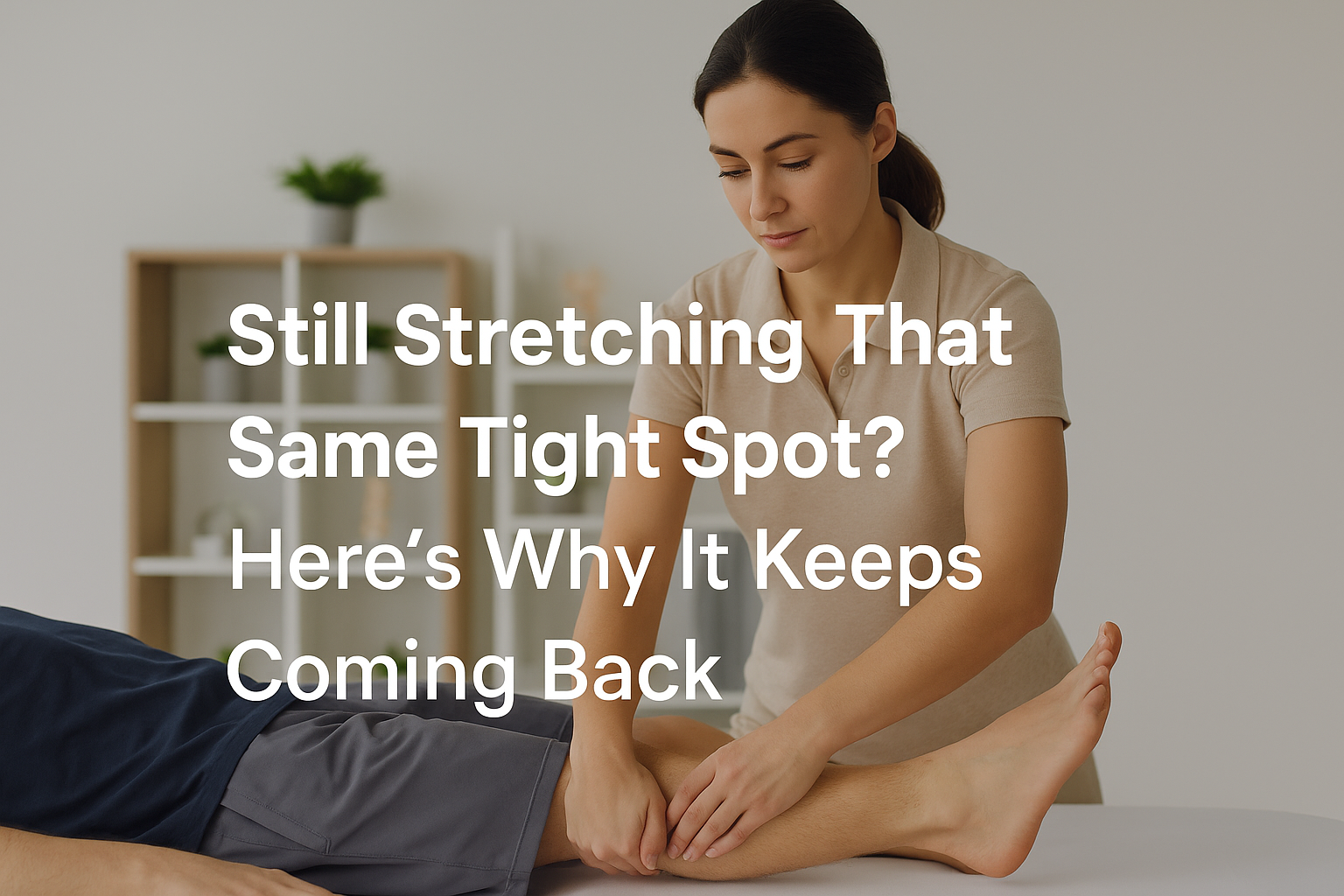Why Stretching Isn’t Fixing Your Muscle Tightness

If you’ve been stretching the same muscle over and over, only for it to tighten right back up, you’re not imagining things — and you’re definitely not alone. Persistent muscle tightness is one of the most common frustrations I see in my osteopathy clinic. The truth? If stretching isn’t working, it’s often because the tight muscle isn’t the real problem at all. Instead, it’s your body’s way of compensating for something else — like a stiff joint, old injury, or movement issue — and until that’s fixed, the tension will keep coming back.
Tony’s Story: How a “Grumpy Hip” Turned Out to Be an Old Ankle Injury
Tony is 68, semi-retired, and absolutely devoted to his twice-weekly golf games. He’s the kind of guy who brings a flask of tea to the course — and will tell you the perfect hole to drink it on.
For months, Tony had been battling what he called his “grumpy hip.” Every round, it would start off fine, but by the 10th hole, it felt like concrete. He’d tried everything to fix it:
- Stretching before and after every game
- Rolling on a spiky massage ball (which he swore hurt more than childbirth — not that he’d know)
- Following “Yoga for Golfers” videos on YouTube
Nothing worked. The tightness always came back.
When Tony came in for an assessment, it didn’t take long to spot something interesting.
The hip wasn’t the main culprit.
The real problem was his left ankle — the same one he sprained a decade ago stepping off a curb outside Tesco. He barely remembered it and thought it had “sorted itself out.”
It hadn’t.
That ankle had become stiff over time. When Tony swung his golf club, the lack of movement in the ankle meant his hip had to work overtime to compensate. The muscles around the hip weren’t tight because they were short — they were tight because they were acting like overworked bodyguards, trying to stabilise an unstable foundation.
Why Stretching Alone Doesn’t Fix Persistent Muscle Tightness
If a muscle is tight because it’s compensating for an issue elsewhere, stretching won’t solve the problem. In fact, the more you stretch, the more the muscle may tighten again — because your body still thinks it needs to “protect” that area.
It’s like telling a security guard to relax while the alarm is still blaring. They’re not going to stop until the real issue is resolved.
The Osteopathy Approach: Treating the Root Cause, Not the Symptom
Once we loosened up Tony’s ankle, adjusted his pelvis (which had subtly shifted over time), and restored proper movement through his body, the hip tension simply faded away.
No more endless stretching routines.
No more limping to the bar after 18 holes.
Just pain-free movement and a better golf swing.
This is the essence of osteopathy: looking at the body as a whole and finding the root cause of your pain, not just chasing symptoms.
When to Suspect Your Tight Muscle Isn’t the Real Problem
If your tightness:
- Always comes back after stretching
- Started after an old injury — even one you thought had healed
- Seems to move or “swap sides”
- Comes with reduced mobility in a nearby joint
…there’s a good chance the problem is somewhere else in your body.
How Osteopathy Helps Relieve Tight Muscles
Osteopathy combines hands-on treatment with a whole-body approach to identify why a muscle is staying tight. This might involve:
- Improving mobility in stiff joints
- Correcting poor movement patterns
- Releasing tension in overworked muscles
- Restoring balance so your body can move efficiently again
The goal isn’t just short-term relief. It’s long-term freedom from pain and restriction.
Frequently Asked Questions About Persistent Muscle Tightness
1. Why do my muscles stay tight even after stretching?
If a muscle is tight because it’s compensating for an issue elsewhere — like a stiff joint, old injury, or poor movement pattern — stretching won’t fix the root cause. Until that underlying problem is addressed, the muscle will keep tightening up.
2. Can old injuries cause muscle tightness years later?
Yes. Even if an injury seemed to “heal” at the time, it can leave behind restricted movement or weakness. Your body may adapt by overworking other muscles, which can lead to long-term tightness.
3. Is stretching bad if my muscle is already overworked?
Stretching isn’t necessarily bad, but if a muscle is acting as a stabiliser for a deeper problem, excessive stretching may give only short-term relief. In some cases, it can even make the muscle feel more unstable.
4. How does osteopathy help with persistent tightness?
Osteopathy looks at the whole body to find and treat the real cause of your muscle tension. Treatment may involve improving joint mobility, correcting movement patterns, and balancing muscle activity so your body can work efficiently.
5. When should I see an osteopath for tight muscles?
If you’ve been stretching the same area for weeks (or years!) with no lasting change — especially if the tightness started after an injury — it’s worth getting assessed by an osteopath.
📅 CLICK HERE to book your osteopathy appointment online today and discover what’s really behind your persistent muscle tightness.
